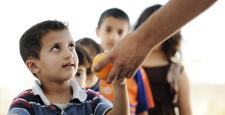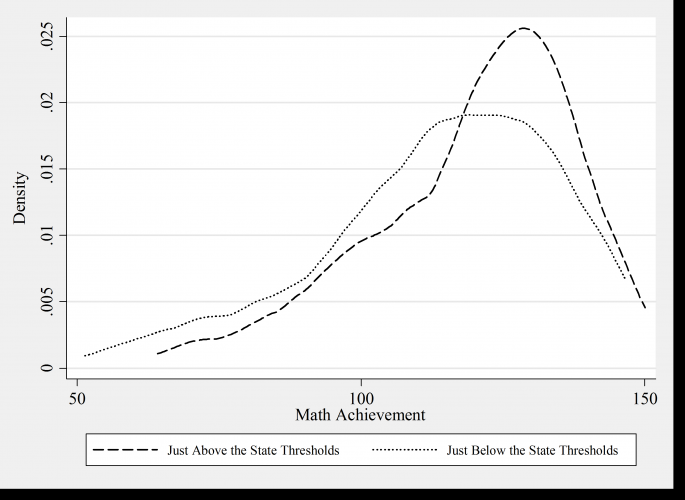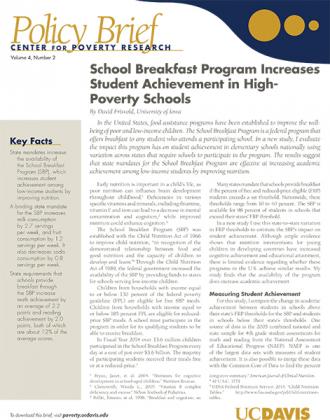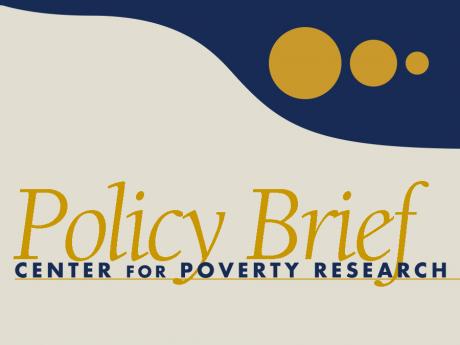School Breakfast Program Increases Student Achievement in High- Poverty Schools
By David Frisvold, University of Iowa
In the United States, food assistance programs have been established to improve the well-being of poor and low-income children. The School Breakfast Program is a federal program that offers breakfast to any student who attends a participating school. In a new study, I evaluate the impact this program has on student achievement in elementary schools nationally using variation across states that require schools to participate in the program. The results suggest that state mandates for the School Breakfast Program are effective at increasing academic achievement among low-income students by improving nutrition.
Early nutrition is important in a child’s life, as poor nutrition can influence brain development throughout childhood.[1] Deficiencies in various specific vitamins and minerals, including thiamine, vitamin E and iron can lead to a decrease in mental concentration and cognition,[2] while improved nutrition could enhance cognition.[3]
Key Facts
- State mandates increase the availability of the School Breakfast Program (SBP), which increases student achievement among low-income students by improving nutrition.
- A binding state mandate for the SBP increases milk consumption by 2.7 servings per week, and fruit consumption by 1.2 servings per week. It also decreases soda consumption by 0.8 servings per week.
- State requirements that schools provide breakfast through the SBP increase math achievement by an average of 2.2 points and reading achievement by 2.0 points, both of which are about 1-2% of the average scores
The School Breakfast Program (SBP) was established with the Child Nutrition Act of 1966 to improve child nutrition, “in recognition of the demonstrated relationship between food and good nutrition and the capacity of children to develop and learn.”[4] Through the Child Nutrition Act of 1989, the federal government increased the availability of the SBP by providing funds to states for schools serving low-income children.
Children from households with income equal to or below 130 percent of the federal poverty guideline (FPL) are eligible for free SBP meals. Children from households with income equal to or below 185 percent FPL are eligible for reduced-price SBP meals. A school must participate in the program in order for its qualifying students to be able to receive breakfast.
In Fiscal Year 2014 over 13.6 million children participated in the School Breakfast Program every day at a cost of just over $3.6 billion. The majority of participating students received their meals free or at a reduced-price.[5]
Many states mandate that schools provide breakfast if the percent of free and reduced-price eligible (FRP) students exceeds a set threshold. Nationwide, these thresholds range from 10 to 40 percent. The SBP is available for 98 percent of students in schools that exceed their states’ FRP threshold.
In a new study I use this state-to-state variation in FRP thresholds to estimate the SBP’s impact on student achievement. Although ample evidence shows that nutrition interventions for young children in developing countries have increased cognitive achievement and educational attainment, there is limited evidence regarding whether these programs in the U.S. achieve similar results. My study finds that the availability of the program does increase academic achievement.
Measuring Student Achievement
For this study, I compare the change in academic achievement between students in schools above their state’s FRP thresholds for the SBP and students in schools below their state’s thresholds. One source of data is the 2003 combined national and state sample for 4th grade student assessments for math and reading from the National Assessment of Educational Progress (NAEP).
NAEP is one of the largest data sets with measures of student achievement. It is also possible to merge these data with the Common Core of Data to find the percent of FRP students in each school. The total sample size from the NAEP for math scores is 53,430 students and for reading scores is 51,640 students. From the math NAEP sample, 35,900 students (67%) attend a school required to participate in the SBP.
The other data source is the Early Childhood Longitudinal Study, Kindergarten Cohort of 1998–99 (ECLS-K), which includes the availability of the SBP and information about consumption and attendance. I use this information to determine the mechanism through which availability of the SBP influences achievement. The sample size from ECLS-K data is 3,040 students. Of these, 2,560 attend a school that participates in the SBP. In this sample, students at schools participating in the SBP have an average family income of approximately half of that of peers in schools that do not participate. The parents of students in participating schools have two fewer years of schooling.
School Breakfast Increases Achievement
The results suggest that state mandates increase the availability of the SBP in schools, which increases student achievement by improving nutrition. Based on NAEP data, the SBP increases math achievement by an average of 2.2 points and reading achievement by 2.0 points, both of which are 0.9 percent of the average scores.
Based on the ECLS-K data, the SBP increases math achievement by 2.0 points, which is 1.8 percent of the average score; reading achievement by 2.7 points, which is 2.0 percent of the average score; and science achievement by 2.2 points, which is 3.8 percent of the average score. These improvements do not reflect differences in the characteristics of the students, parents or schools.
The ECLS-K data also suggest that the availability of the SBP improves nutrition. A binding state mandate increases milk consumption by 2.7 servings per week and fruit consumption by 1.2 servings per week. It also decreases soda consumption by 0.8 servings per week.
State Requirements Make a Difference
The binding nature of state mandates for the SBP make a difference in whether schools provide the meals. Students in schools with a binding state mandate are 40.4 percentage points more likely to attend a school that offers breakfast through the SBP even though the difference in the percent of FRP students in the school is only 6.6 percentage points.
Based on the ECLS-K sample, a binding state mandate increases math achievement by 8.1 points and reading achievement by 9.7 points throughout the course of elementary school for low-income students. A binding state mandate also implies that the availability of the SBP increases breakfast consumption at school by 17 percentage points.
Lifelong Improvements
Overall, these results suggest that nutrition interventions can improve cognitive achievement. In the long run, these programs make a difference for low-income students. Childhood health, nutrition and cognitive achievement are important determinants of human capital as adults. This suggests that policies that improve a young child’s nutrition not only have the short-run effects of increasing test scores throughout early schooling, but that these effects could make a difference well into a child’s life.
David Frisvold is an Assistant Professor of Economics at the University of Iowa.
[1] Bryan, Janet, et al. 2004. “Nutrients for cognitive development in school-aged children.” Nutrition Reviews.
[2] Chenoweth, Wanda L., 2007. “Vitamin B complex deficiency and excess.” Nelson Textbook of Pediatrics.
[3] Pollitt, Ernesto, et al. 1998. “Breakfast and cognition: an integrative summary.” American Journal of Clinical Nutrition.
[4] 42 U.S.C. 1771
[5] UDSA Federal Nutrition Service. 2015. “Child Nutrition Tables.” http://www.fns.usda.gov/pd/child-nutrition-tables.
#povertyresearch













